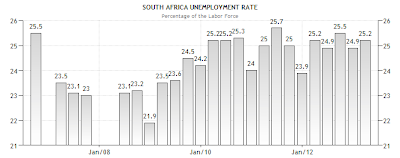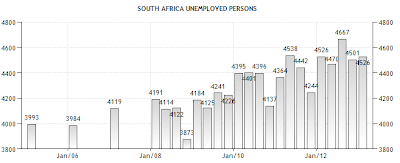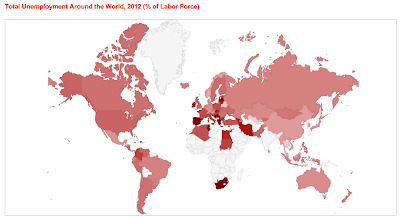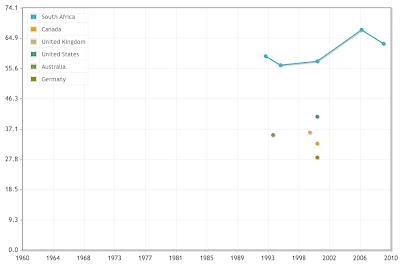South Africa truly is one of the world's most beautiful nations. I spent some time there twenty years ago, travelling through the country by car from north to south and east to west and there are few nations on earth that can rival its natural beauty. One of the most vivid scenic memories that I have seen anywhere in the world is coming through a mountain pass and seeing the valley containing Franschhoek open before my eyes. Although apartheid was officially behind the nation, the remnants were still there; such mundane things as two sets of washrooms at many service/petrol stations were obvious signs of the former division of the nation.
At that time, it was fascinating to see the difference between the two South Africas. One was extremely wealthy; living in either gated communities or behind high walls and the other, living in crowded townships under sheets of corrugated tin. We stayed with one Afrikaner couple, very friendly people, who, at the time, owned one of the world's largest car collections with one vehicle alone valued at well over a million dollars. We also spent time talking to black South Africans who were very anxious about their futures, assuming that the end of apartheid meant the automatic transition to a wealthy lifestyle that they so envied in their former taskmasters.
Unfortunately, the dream did not necessarily come true for many South Africans.
Here is a graph showing South Africa's official unemployment rate since 2008:
Here is a graph showing the growing number of unemployed South Africans since 2002:
As in most nations, the unemployment rate only includes those who are actively looking for a job but cannot find work. According to The Economist, the real unemployment rate in South Africa is likely closer to the 40 percent mark, putting it among the worst in the "developed" world as shown on this map where darker red nations have higher unemployment:
You may recall the Gini index. This index measure the extent to which the distribution of income (or, in some cases, consumption expenditure) among individuals or households within an economy deviates from a perfectly equal distribution. This means that a Gini index of 0 represents perfect equality, while an index of 100 (or 1 in some cases) implies perfect inequality.
Here is a graph showing South Africa's Gini index since 1993 just after the official end of apartheid:
Rather than getting better, South Africa's Gini index got worse over the long-term. According to the CIA World Factbook, South Africa's Gini is the second highest in the world after Lesotho.
Here is a graph comparing the Gini index for South Africa to those of other developed economies showing how elevated it is:
While the end of apartheid has brought the degree of absolute poverty down to more reasonable levels, it is obvious that the dream of economic equality has not come true. The gap between the rich and the poor in the nation is huge. Many believe that this is the case because the South African economy relies on the mining industry for its wealth rather than diversifying into manufacturing, a move that would create additional jobs and end the massive unemployment problem in the nation.
Is the post-apartheid dream dead? Perhaps not, but it certainly appears that it is on life-support despite the desires of the non-white population.
Click HERE to read more of Glen Asher's columns
You can publish this article on your website as long as you provide a link back to this page.






Be the first to comment